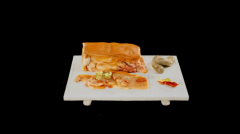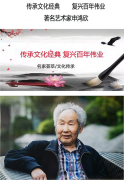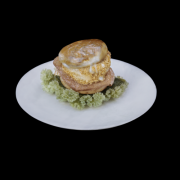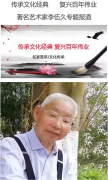|
明代的玉有和田玉、南阳玉、釉岩玉、蓝天玉,还有玛瑙、水晶等等,其中和田玉最具代表性,数量也比较丰富。品种有佩饰品、艺术晶、实用品、复古品及少数量的礼器。造型和纹饰,我国文物收藏之风就已萌发,金石之学兴起,到了明代尚古风气仍在流行,集古玉与鉴赏古玉为时尚。 The jades of the Ming Dynasty include Hotan jade, Nanyang jade, glazed rock jade, Lantian jade, agate, crystal and so on. Hotan jade is the most representative and abundant in quantity. Varieties include jewelry, artistic crystal, practical products, retro products and a small number of ritual vessels. Modeling and decoration, the trend of cultural relics collection in China has sprouted, and the study of gold and stone has sprung up. In the Ming Dynasty, the fashion of advocating ancient jade is still popular, and it is fashionable to collect and appreciate ancient jade.
汉人多束发,这是华夏民族的传统习尚。明朝统治者十分重视整顿和恢复传统的汉族礼仪,根据汉人习俗,上采周汉,下取唐宋,制定了严格的礼仪制度。其中一项,是明太祖严禁国人辫发,因此,明代汉人不分男女,多采取束发,男子束发后再用冠或巾罩住,女子则再饰以簪钗、插梳和步摇等。根据考古和文献资料显示,明朝时期,随着手工业和商品经济的高度发展、玉料开采的来源广泛,玉器生产和使用的规模空前,因此,明代佩戴各种玉发饰的习俗十分普遍。玉发饰的形制主要有发冠、玉簪、玉梳、玉发箍等,本文仅对江苏常熟博物馆收藏的几种代表性的明代玉发饰作一简要赏析。 Han people often have their hair tied, which is a traditional custom of the Chinese nation. The rulers of the Ming Dynasty attached great importance to rectifying and restoring the traditional Han etiquette. According to the Han customs, they adopted the Zhou and Han Dynasties and the Tang and Song Dynasties, and formulated a strict etiquette system. One of them is that emperor Taizu of the Ming Dynasty strictly prohibited Chinese people from braiding their hair. Therefore, Han people in the Ming Dynasty, regardless of men and women, mostly tied their hair. After the men tied their hair, they covered it with a crown or towel, while women were decorated with hairpins, combs and steps. According to Archaeology and literature, during the Ming Dynasty, with the high development of handicraft industry and commodity economy, the sources of jade mining were extensive, and the scale of jade production and use was unprecedented. Therefore, the custom of wearing all kinds of jade hair ornaments in the Ming Dynasty was very common. The shapes of jade hair ornaments mainly include hair crown, jade hairpin, jade comb, jade hair hoop, etc. This paper only makes a brief appreciation of several representative Ming Dynasty jade hair ornaments collected in Jiangsu Changshu Museum.
为什么明代玉相对多呢?这与当时的历史有关。明代皇帝、皇亲与一品文武以上官员,他们的着装很多,有朝服、公服、常服等,不同场合着不同的服饰,戴不同的玉带。玉带在明代是地位与权利、等级与财富的象征,对于上层官吏来说拥有玉带标志身份高贵,然而玉发髻,也成了这些女子的佩戴。 Why is there so much jade in the Ming Dynasty? This is related to the history at that time. The emperors, Royal relatives and officials above the first grade civil and military level in the Ming Dynasty wore a lot of clothes, including court clothes, public clothes and regular clothes. They wore different clothes and jade belts on different occasions. The jade belt was a symbol of status, power, rank and wealth in the Ming Dynasty. For the upper officials, having the jade belt marked their noble status. However, the jade bun also became the wear of these women.
《释名》上说:“冠,贯也,所以贯韬发也。”冠不同于现在的帽子,它是贯穿、固定发髻的圆圈。明代男子束戴冠,先把头发盘成发髻,然后把发冠套在发髻上,再插入笄、簪固定头发与发冠,使头发不至于散落。 "Shi Ming" said: "the crown is also through, so it is also through Tao's hair." the crown is different from the current hat. It is a circle that runs through and fixes the bun. Men in the Ming Dynasty wore crowns. They first rolled their hair into a bun, then put the hair crown on the bun, and then insert hairpins and hairpins to fix their hair and hair crown, so that their hair would not scatter.
明代妇女发式颇多,有“挑尖顶髻”“鹅胆心髻”“堕马髻”等等,发髻上的装饰也有不少名堂,尤其贵妇人更注重头上的妆饰,大量使用玉簪钗、玉步摇、玉插梳等。其中玉簪是比较常见的一种。玉簪由簪首和簪柄两部分组成,簪柄一般为光素圆柱或呈扁方形,簪首普遍加以装饰,有几何形、龙形、凤鸟等造型。现撷取馆藏的两件明代玉簪同读者共赏。 There were many Hairstyles for women in the Ming Dynasty, such as "pointed top bun", "goose gall heart bun", "falling horse bun", etc. there were also many famous decorations on the bun. Especially, expensive women paid more attention to the makeup on their heads, and used a large number of jade hairpins, hairpins, jade steps, jade inserted combs, etc. Among them, Hosta is a common one. The jade hairpin is composed of a hairpin head and a hairpin handle. The hairpin handle is generally a plain cylinder or a flat square. The hairpin head is generally decorated, with geometric shapes, dragon shapes, Phoenix shapes, etc. Now we will take two pieces of jade hairpins from the Ming Dynasty and enjoy them with readers.
明朝社会已经发展到高度成熟阶段,明代玉器生产和使用的规模胜过宋元,而玉材本身的价值,决定了消费对象以社会的上层人士为主,要有一定身份地位的人才能佩戴。明代的玉发饰注重对细部的雕琢与刻画,以阴刻线和浅浮雕为主要技法,寥寥几笔勾勒便呈现简约优美的效果。其本身不仅具有装饰性,而且有着深刻的文化内涵。首先,两件明代玉发冠除了装饰性以外,也是身份和地位的象征,更是明代等级制度的体现。戴偃月冠者多为文人士大夫,戴梁冠者为朝中文武官员。其次,从玉簪和玉梳上的纹饰可以窥知,当政治经济文化发展到一定高度,人们开始注重对美好生活的向往和追求,将装饰性极强的吉祥图案大量运用到玉雕作品中,或谐音,或寓意,鹊梅纹和龙纹凤纹即是如此。以上四件玉发饰体现了明代森严的等级制度和人们对世俗愿望的追求,为我们呈现了一种多面性的明代社会风尚。 The society of the Ming Dynasty has developed to a highly mature stage. The scale of jade production and use in the Ming Dynasty is better than that in the song and Yuan Dynasties. The value of jade material itself determines that the consumption object is mainly the upper class of the society, and people with a certain status can wear it. The jade hair ornaments of the Ming Dynasty pay attention to the carving and depiction of details. The main techniques are Yin engraved lines and shallow relief. A few sketches show a simple and beautiful effect. It is not only decorative, but also has profound cultural connotation. First of all, the two jade hair crowns of the Ming Dynasty are not only decorative, but also a symbol of identity and status, but also the embodiment of the hierarchy of the Ming Dynasty. Most of those who wear Yan Yue Guan are literati doctors, and those who wear Liang Guan are Chinese military officials of the dynasty. Secondly, from the patterns on the jade hairpin and jade comb, we can see that when the political, economic and cultural development reaches a certain height, people begin to pay attention to the longing and pursuit of a better life, and apply a large number of decorative auspicious patterns to jade carving works, or homonym or allegory, such as magpie plum pattern, dragon pattern and phoenix pattern. The above four jade hair ornaments reflect the strict hierarchy of the Ming Dynasty and people's pursuit of secular aspirations, and present us with a multifaceted social fashion of the Ming Dynasty. 此四件明代四件玉发髻保存非常完美,品相及加,刀法纤巧,流畅,刀锋外漏,装饰性强,也体现出了当时人们为了追求时尚所呈现出来的,希望广大客户选购跟购买! These four jade hair bun of the Ming Dynasty are perfectly preserved, with good appearance and addition. The knife technique is delicate, smooth, the blade leaks out, and strong decoration. It also reflects what people presented at that time in order to pursue fashion. I hope customers can buy and buy! |

古玩城2021精品推荐:明代古玉发髻四件套
来源: 作者:admin 人气: 发布时间:2021-12-06 12:34
下一篇:没有了

频道精选
- Hi-Five一下 惊喜诞生# 高合HiPhiX发布圣诞“2020-12-24
- 传承文化经典 复兴百年伟业著名艺术家徐德伦2021-10-15
- 传承文化经典 复兴百年伟业 著名艺术家张亚辉2021-10-15
- 乐融儿童之家:早教托育一体化是必然的趋势2020-05-13
- 爹地宝贝响应战“疫”号召 持续优化产能2020-05-09
- 国庆中秋去哪儿嗨?北京清凉谷邀你玩! 2020-09-28
- 为人民谋事 为孩子点灯——钟南山院士创新公2020-08-14
- 传承文化经典 复兴百年伟业著名艺术家吴广华2021-10-13
- 2020年江西省南昌大学医学类成人高考,考生报2020-07-23
- 天管委收藏书家----张小东2020-10-28
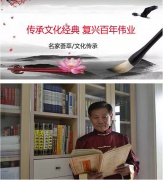 传承文化经典 复兴百年伟业著名艺术家徐德
传承文化经典 复兴百年伟业著名艺术家徐德浏览次数:125次
羊草︱怀抱古今——当代中国画中坚60家笔墨
浏览:0次
心志高洁 其香清逸——国画名家周维萍浏览:0次
浏览:0次
中国服装呼唤“攀登者”,用技术创新构筑专浏览:115次
山水田园画世界的艺术中国的华章浏览:105次
搜救10000名缺铁人,德国小红脸发起“铁人浏览:64次
严学章︱借古开今——当代中国画60家笔墨研浏览:0次
精诚大医杨民浏览:0次
中医药行业优秀模范人才-葛正法浏览:0次







